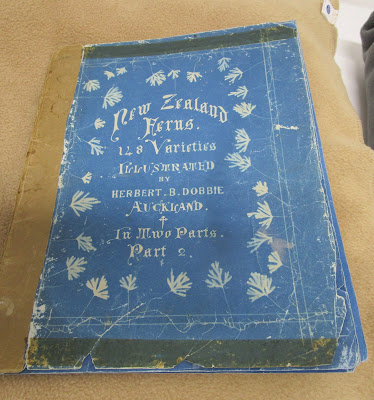I got spectacular results printing between about 11 a.m. and 1 p.m., when the sun was at its strongest. The rich indigo of the background was the perfect way to draw attention to the lines of the fern fronds.
Over the next few months I made several pieces which incorporated these prints. I especially enjoyed being able to combine them with African, Japanese and batik indigo prints I'd collected over the years. Even shirting scraps combined well, as well as the indigo shibori fabric our small Fibre Art group made together the previous summer.
Some of the tiniest ferns were perfect for card-making, and disappeared at our group exhibit at the Ladysmith Art Gallery in August. So I had returned to New Zealand on the lookout for more ferns, and thinking about how to work with them. One day very recently, I was looking through a book that was issued in conjunction with a photography exhibit at Te Papa - the National Museum, and was intrigued when I turned the page to find this:
It is a cyanotype print on paper, made in 1880, by Herbert Dobbie. Herbert was an engineer who lived in Auckland, and who had a fondness for ferns. This was before cameras were commonly available, and he turned to cyanotype to record his findings.
He recorded 148 different varieties of ferns in this manner, and published them in what is now known as his "Blue Books". Only 14 copies still exist worldwide, and several of them are at Te Papa in Wellington. After doing a little research, I discovered that I could make an appointment to see rare books in the collections department of the museum, and this is just what I did. I couldn't quite believe it was that easy.
Most of the pages are still is excellent shape. The person helping me said the faded ones had probably been exposed to light at some point.
But even then, they were fabulous. Such an exciting discovery. I put on the gloves provided, and slowly turned the pages one by one.
I had also asked to see the New Zealand Ferns book by Dobbie that was published in 1921, and became the authority on New Zealand ferns for over 50 years. It's in black and white, and have jest learned that copies are available even now, and for a reasonable amount, as the book was reissued a few years ago.
What I didn't know, and what was the most exciting of all, was that Te Papa also has the original photo album of all the photos that were eventually included in that 1921 book. And it was incredible.Here's a side-view, showing the depth of it. And it was in excellent shape. What a treasure!
Each specimen had been carefully photographed, with the name had been added, in a most careful and exact manner.
And there were photographs showing the size of some samples, in relation to the size of people. Needless to say, I've already ordered a copy of the it for myself. And am more excited than ever to pursue this area of research, ready to see what work results from my investigations. I'm beginning to understand far more deeply, why it's so important to do the research in your area of interest as you move forward with the actual making. It leaves me with the feeling that I've met this pioneer in printing ferns, and share his interest in printing in blue, if not having the scientific bent required to push this in a more scientific direction. Thank you, Herbert Dobbie.














Totally cool, Pippa! What an intriguing discovery for you.
ReplyDeleteI can imagine Herbert Dobbie being very excited that an artist is inspired by his scientific records and pushing them in your particular direction.
ReplyDelete